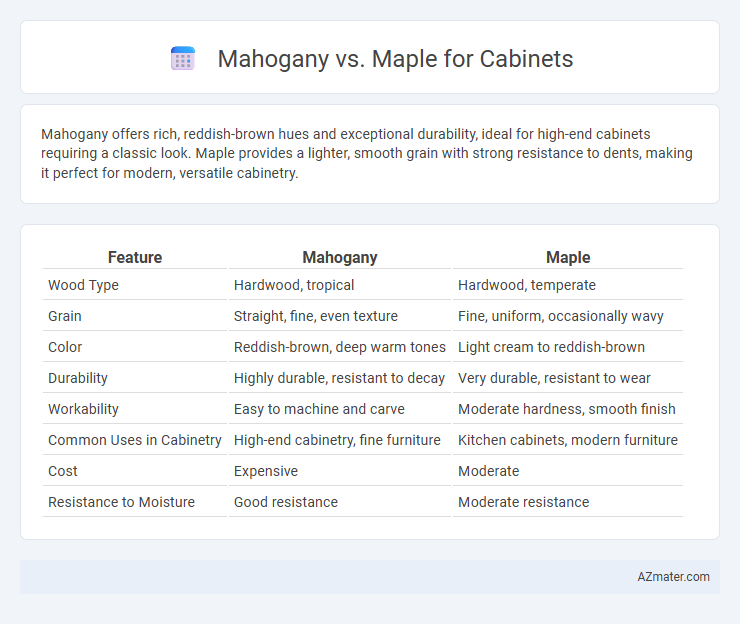Mahogany offers rich, reddish-brown hues and exceptional durability, ideal for high-end cabinets requiring a classic look. Maple provides a lighter, smooth grain with strong resistance to dents, making it perfect for modern, versatile cabinetry.
Table of Comparison
| Feature | Mahogany | Maple |
|---|---|---|
| Wood Type | Hardwood, tropical | Hardwood, temperate |
| Grain | Straight, fine, even texture | Fine, uniform, occasionally wavy |
| Color | Reddish-brown, deep warm tones | Light cream to reddish-brown |
| Durability | Highly durable, resistant to decay | Very durable, resistant to wear |
| Workability | Easy to machine and carve | Moderate hardness, smooth finish |
| Common Uses in Cabinetry | High-end cabinetry, fine furniture | Kitchen cabinets, modern furniture |
| Cost | Expensive | Moderate |
| Resistance to Moisture | Good resistance | Moderate resistance |
Introduction to Mahogany and Maple Cabinets
Mahogany cabinets are prized for their rich, deep reddish-brown tones and exceptional durability, making them a popular choice for high-end furniture and cabinetry. Maple cabinets feature a lighter, creamy color with a smooth grain pattern, known for their strength and resistance to wear, often used in modern and contemporary kitchen designs. Both woods offer excellent workability and finish potential, but mahogany provides a more luxurious aesthetic while maple ensures a clean, bright appearance.
Key Characteristics of Mahogany Wood
Mahogany wood features a rich reddish-brown color, exceptional durability, and a fine, straight grain, making it ideal for high-end cabinetry. Its natural resistance to rot and insect damage ensures longevity, especially in humid environments, while its smooth texture allows for a premium polished finish. Compared to maple, mahogany offers a deeper hue and a more luxurious appearance, often favored for classic and ornate cabinet designs.
Key Characteristics of Maple Wood
Maple wood features a light, creamy color with a smooth, consistent grain pattern that enhances cabinet aesthetics. Its hardness and durability make it highly resistant to dents and scratches, ideal for high-traffic kitchen environments. Maple's ability to take stains evenly allows for versatile finishing options, maintaining long-lasting beauty in cabinetry.
Appearance and Grain Comparison
Mahogany exhibits a rich, reddish-brown hue with a fine, straight grain that offers a smooth, elegant appearance ideal for classic and high-end cabinetry. Maple features a lighter, creamy to off-white color with a subtle, consistent grain pattern that provides a clean, modern look suitable for versatile design styles. The contrast between mahogany's warm, deep tones and maple's bright, uniform surface allows homeowners to select based on desired aesthetic impact and room ambiance.
Durability and Hardness Differences
Mahogany offers moderate durability with a Janka hardness rating around 800, making it softer and more prone to dents compared to maple. Maple is significantly harder, with a Janka hardness of approximately 1450, providing superior resistance to scratches and impacts in cabinet applications. Choosing maple for cabinetry ensures enhanced longevity and durability, especially in high-traffic or heavy-use areas.
Color and Finish Options
Mahogany offers rich, deep reddish-brown hues that darken beautifully over time, providing a classic, elegant look ideal for traditional cabinetry. Maple features a lighter, creamy color palette with subtle grain patterns, allowing for versatile staining options that range from natural to vibrant finishes. Both woods respond well to various finishes, but mahogany's natural oils enhance its sheen, while maple's smooth surface allows for a more uniform application of stains and paints.
Maintenance and Care Requirements
Mahogany cabinets demand regular dusting and occasional polishing due to their natural oils, enhancing wood grain and preventing drying or cracking. Maple requires less frequent polishing but benefits from gentle cleaning with mild soap and water to maintain its smooth, dense surface and resist staining. Both woods should avoid excessive moisture exposure to prevent warping and maintain longevity in cabinet applications.
Cost Analysis: Mahogany vs Maple
Mahogany cabinets typically cost between $25 and $40 per square foot, reflecting their premium status and rich, deep reddish-brown color, while maple cabinets average $15 to $30 per square foot, offering a lighter tone and smoother grain at a lower price point. The higher cost of mahogany is driven by its slower growth rate and limited supply, which enhances its desirability and durability but increases expense. Maple provides a cost-effective alternative with strong hardness and resistance to dents, making it a practical choice for budget-conscious homeowners without sacrificing quality.
Best Applications for Each Wood Type
Mahogany excels in luxury cabinetry and high-end furniture due to its rich color, fine grain, and exceptional durability, making it ideal for formal kitchens and classic designs. Maple offers superior hardness and smooth grain, perfect for contemporary and modern cabinetry that requires a clean, light finish and resists dents and scratches. Both woods perform well in various environments, but choosing mahogany is best suited for elegant, traditional aesthetics, while maple fits well in functional, minimalist spaces.
Choosing the Right Wood for Your Cabinets
Mahogany offers rich, deep reddish-brown hues and exceptional durability, making it ideal for high-end cabinets that require a luxurious appearance and long-lasting strength. Maple features a lighter color palette with fine, consistent grain patterns, providing a versatile and cost-effective option for modern or traditional cabinet styles. Selecting the right wood depends on your desired aesthetic, budget, and the cabinet's intended use, with mahogany excelling in elegance and maple favored for its stability and affordability.

Infographic: Mahogany vs Maple for Cabinet
 azmater.com
azmater.com